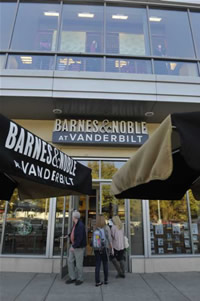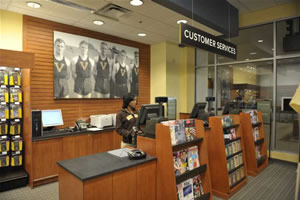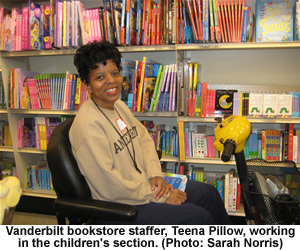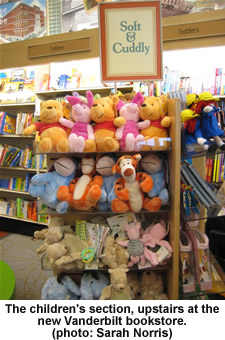Bigger, Better, and Full of Books
The new Barnes & Noble at Vanderbilt throws open its doors, and Nashville readers are wowed
 As an institution, the bookstore is in decline. In Nashville alone, one after another has closed its doors: Bookstar, Davis-Kidd, OutLoud, Borders—the list goes on. In assessing those vacant shelves, a visiting anthropologist from another planet could only conclude that people here just aren’t that interested in reading anymore. But, in truth, Nashvillians never stopped reading books. They didn’t even stop buying books. They simply stopped having a place to buy books in town. So the official grand opening on November 11—though the store’s actually been open for business since October 31—of the new Barnes & Noble at Vanderbilt marks a 26,000-square-foot cause for major celebration.
As an institution, the bookstore is in decline. In Nashville alone, one after another has closed its doors: Bookstar, Davis-Kidd, OutLoud, Borders—the list goes on. In assessing those vacant shelves, a visiting anthropologist from another planet could only conclude that people here just aren’t that interested in reading anymore. But, in truth, Nashvillians never stopped reading books. They didn’t even stop buying books. They simply stopped having a place to buy books in town. So the official grand opening on November 11—though the store’s actually been open for business since October 31—of the new Barnes & Noble at Vanderbilt marks a 26,000-square-foot cause for major celebration.
Remember You’ve Got Mail, the 1998 movie starring Meg Ryan as the owner of a cozy, children’s bookstore in Manhattan? Tom Hanks’s character is an owner of the mega-chain bookstore that opens around the corner, swiftly knocking Ryan’s small, independent store out of business. The main plotline, of course, involves a love story between the two protagonists, but watching the film today, the longing that comes through is less a question of true love and more a nostalgia for books—for access to all those books. It’s the desire to walk into any bookstore at all, small or large. It’s the urge to get offline and touch actual books.
For the sake of a thriving literary culture, it’s truly crucial to have a great independent bookstore in town, but the enemy of the local independent is no longer the big-box chain store around the corner; it’s the unfair pricing advantage enjoyed by Amazon. Besides, when you live in a city with no bookstore at all, you think better of casting those sprawling, boxy giants as villains. Last spring, when the West End Borders went out of business on the heels of Davis-Kidd’s bankruptcy, I realized I’d taken for granted the pleasure of a place where I could meet a friend for coffee, check out the new fiction releases, and have something gift-wrapped for free. Of course there’s always the true-blue library, but for the past five months I’ve missed wandering around in a bookstore, sitting down with a new book or magazine, doing some excellent people-watching, and talking in an actual speaking voice.
 Maybe this is simply five months of deprivation talking, but I’m moved to compare the experience of walking into Barnes & Noble at Vanderbilt to that of visiting the Sistine Chapel. It is, frankly, grand. The new campus store is only 7,000 square feet larger than the old Rand location, but the place feels, for many reasons, about a million times bigger. I walked in one day last week and spent the first thirty seconds gawking at the sheer volume of books and the height of the ceilings and the energy. It was like driving by a favorite old house I’d given up as abandoned and finding out that not only is it occupied, but there’s also an enormous party going on there. Inside, 67,000 trade titles are waiting, along with a total of seventy-nine employees to help readers find new books they’ll love.
Maybe this is simply five months of deprivation talking, but I’m moved to compare the experience of walking into Barnes & Noble at Vanderbilt to that of visiting the Sistine Chapel. It is, frankly, grand. The new campus store is only 7,000 square feet larger than the old Rand location, but the place feels, for many reasons, about a million times bigger. I walked in one day last week and spent the first thirty seconds gawking at the sheer volume of books and the height of the ceilings and the energy. It was like driving by a favorite old house I’d given up as abandoned and finding out that not only is it occupied, but there’s also an enormous party going on there. Inside, 67,000 trade titles are waiting, along with a total of seventy-nine employees to help readers find new books they’ll love.
Barnes & Noble at Vanderbilt has all the features a reader would expect from Barnes & Noble superstore, but because it’s also a campus bookstore—B&N College, a wholly owned subsidiary, manages 600 university bookstores around the country—it has all sorts of unexpected and hilarious accoutrements, as well. Upstairs, along with racks and racks of school-spirit sweatshirts and other clothing for students, alumni, and fans, there’s a wall of graphing calculators and dorm-room filler: coat-hangers, plastic trashcans, Dirt Devil vacuums, laundry hampers, toaster ovens, storage cubes, coffee makers, filtered-water pitchers, alarm clocks, electric kettles, gooseneck clip-lamps, emergency sewing kits, and batteries. There’s an entire shelf of giant, stuffed-animal microbes (mono, a brain cell, E. coli, the common cold); these, a clerk informed me, will eventually be displayed in the medical section.
 “This [store] is definitely easier to find,” said Laura Hardwicke, a graduate student at Peabody, who held several Vanderbilt bumper stickers in one hand. “I’m going to send these to my parents,” she told me, eyeing an Office DVD collection.
“This [store] is definitely easier to find,” said Laura Hardwicke, a graduate student at Peabody, who held several Vanderbilt bumper stickers in one hand. “I’m going to send these to my parents,” she told me, eyeing an Office DVD collection.
Sorting books in the children’s section, Teena Pillow explained that she’d been working in the business office at the Vanderbilt bookstore for a long time when she was asked to move to the children’s area of the new location. “I like children,” she said, smiling. “It’s comfortable.” When asked about her favorite children’s book, she named The Little Engine That Could. “I have M.S., so it’s nice to feel necessary, and that book has my motto: I think I can, I think I can!”
Shayan Ahmed, a Vanderbilt senior double-majoring in political science and medicine, health, and society, sat upstairs in an upholstered armchair by the glass walls, listening to his iPod while reading Helen Epstein’s Invisible Cure, about the AIDS epidemic in Africa. “I’d never come [to the old bookstore] to read,” he said, citing Fido’s and JJ’s as favorite study spots. “But this is better than a coffee shop because here you can take breaks.” He’d brought along another book to read for class; after that, he said, “I’m going to buy the latest GQ magazine.”
 At a nearby round table sat Tiffani, a third-grade public-school teacher who declined to give her last name. She typed on her Toshiba computer while waiting for a teacher friend. “I get more work done here because it’s quiet but not too, too quiet,” she said, “and I feel less reclusive than I do working at home.” Nearby a retired schoolteacher who preferred not to be quoted by name was looking for a GRE review book. When asked why she hadn’t bought the book online, she explained that, in fact, she’d already looked it up online and planned to head home to compare the prices. “I came here,” she said, “because I wanted to hold the book in my hands and check it out.” (In fact, this strategy—shopping in a store but buying online—is a huge challenge to the survival of bricks-and-mortar bookstores. If every book buyer in Barnes & Noble comes to the store only to look a book over before buying it on Amazon, Barnes & Noble will not long survive, no matter how many Vandy t-shirts it sells.)
At a nearby round table sat Tiffani, a third-grade public-school teacher who declined to give her last name. She typed on her Toshiba computer while waiting for a teacher friend. “I get more work done here because it’s quiet but not too, too quiet,” she said, “and I feel less reclusive than I do working at home.” Nearby a retired schoolteacher who preferred not to be quoted by name was looking for a GRE review book. When asked why she hadn’t bought the book online, she explained that, in fact, she’d already looked it up online and planned to head home to compare the prices. “I came here,” she said, “because I wanted to hold the book in my hands and check it out.” (In fact, this strategy—shopping in a store but buying online—is a huge challenge to the survival of bricks-and-mortar bookstores. If every book buyer in Barnes & Noble comes to the store only to look a book over before buying it on Amazon, Barnes & Noble will not long survive, no matter how many Vandy t-shirts it sells.)
The ground-floor Starbucks café sells Ben & Jerry’s ice-cream by the pint, along with coffee, soft drinks, sandwiches, quiche, chips, chocolates, fresh soups, Vanderbilt coffee mugs, and “Black and Gold” mochas. Outside, there’s a paved area with tables, which will make for a wonderful spot to lunch and study in warm weather. In the café, where most of the tables were full, I noticed a woman who earlier had been reading a picture book to her two young daughters. When the smaller girl darted off into the travel section, the mother exclaimed, “We can’t just let Stella run amok in the store!”
Because I could see Stella’s blond pigtails peeking out behind South America, I wasn’t worried. Just to have, again, a store so large and filled with books that you could imagine getting lost in it—that’s a sweet relief.
The grand opening of Barnes & Noble at Vanderbilt will take place all day November 11 and will feature appearances by Marshall Chapman, Loveless Café pastry chef and cookbook author Alisa Huntsman, Vanderbilt coaches James Franklin and Melanie Balcomb, the Melodores a capella group, and Curious George. For more info, click here.


